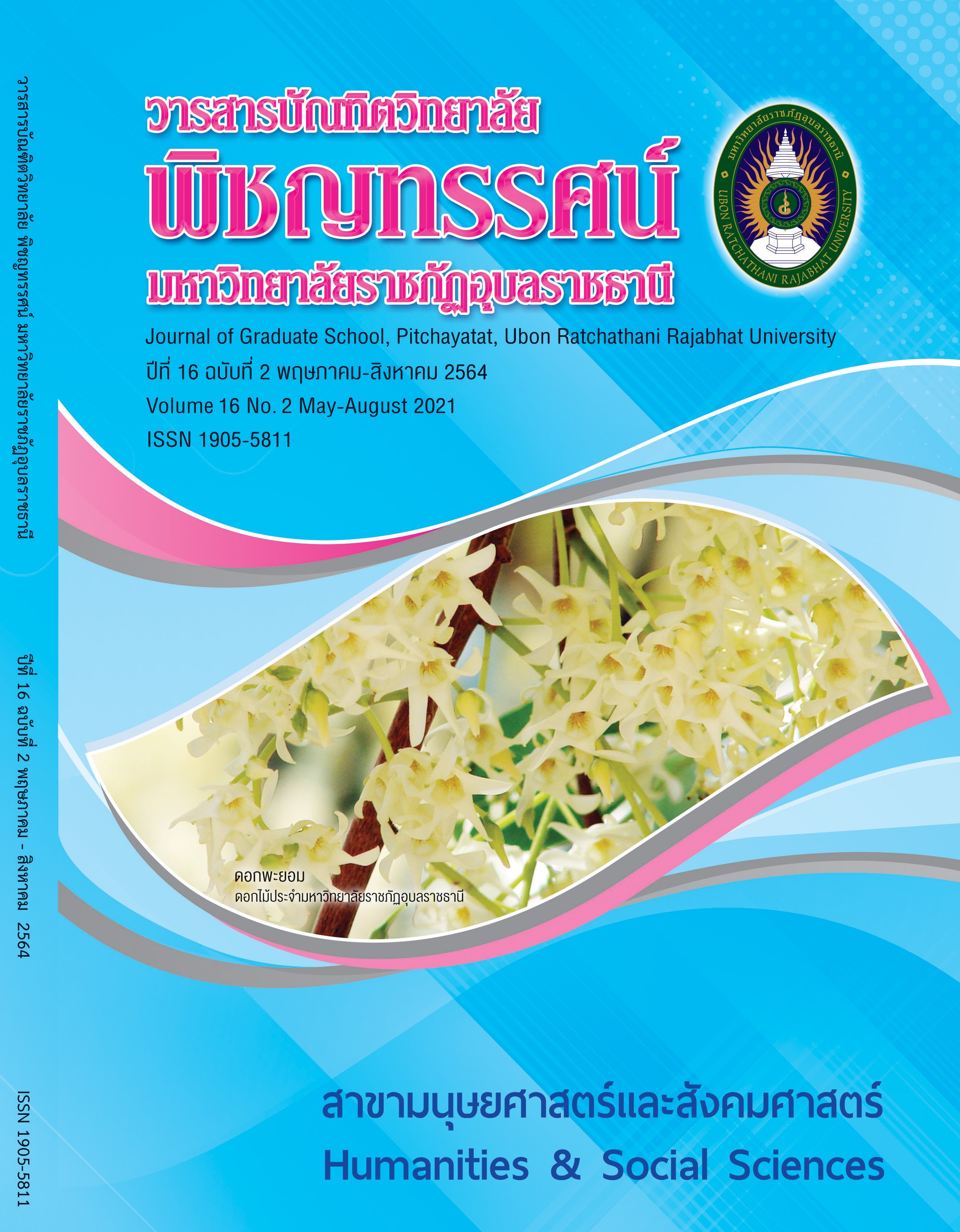ความเป็นไปได้ในการพัฒนาการท่องเที่ยวเชิงสุขภาพแบบแพทย์ทางเลือกอย่างสร้างสรรค์ ในจังหวัดอุบลราชธานี: กรณีศึกษา บ้านเกษตรพัฒนา เทศบาลตำบลคำขวาง อำเภอวารินชำราบ จังหวัดอุบลราชธานี
คำสำคัญ:
การท่องเที่ยวเชิงสุขภาพแบบแพทย์ทางเลือกอย่างสร้างสรรค์, หลัก 8 อ. รูปแบบการท่องเที่ยว, เทศบาลตำบลคำขวางบทคัดย่อ
การวิจัยนี้มีวัตถุประสงค์เพื่อ 1) ศึกษารูปแบบของผลิตภัณฑ์การท่องเที่ยวเชิงสุขภาพแบบแพทย์ทางเลือกอย่างสร้างสรรค์ร่วมกับชุมชนเจ้าของพื้นที่ 2) ศึกษาความเป็นไปได้ในการพัฒนาการท่องเที่ยวเชิงสุขภาพแบบแพทย์ทางเลือกอย่างสร้างสรรค์ และ 3) นำเสนอแนวทางในการพัฒนาการท่องเที่ยวเชิงสุขภาพแบบแพทย์ทางเลือกอย่างสร้างสรรค์ที่เหมาะสมสำหรับจังหวัดอุบลราชธานี ในการศึกษารูปแบบผลิตภัณฑ์การท่องเที่ยวผู้วิจัยใช้ระเบียบวิธีวิจัยแบบผสานวิธี นักวิจัยใช้ระเบียบวิธีวิจัยเชิงปริมาณใช้แบบสอบถามเป็นเครื่องมือในการสำรวจความต้องการด้านอุปสงค์ในกลุ่มตัวอย่างที่เป็นนักท่องเที่ยวที่เดินทางมาเที่ยวจังหวัดอุบลราชธานี จำนวน 245 คน ใช้วิธีสุ่มตัวอย่างสุ่มตัวอย่างแบบบังเอิญ (Accidental Sampling) และใช้สถิติเชิงพรรณา (Descriptive Statistic) ในการนำเสนอข้อมูลที่เก็บรวบรวมมาในรูปแบบของค่าเฉลี่ย ร้อยละ ส่วนเบี่ยงเบนมาตรฐาน และใช้ระเบียบวิธีวิจัยเชิงคุณภาพในการค้นหาศักยภาพของพื้นที่(อุปทาน) เก็บข้อมูลด้วยการสัมภาษณ์แบบเจาะลึก (In-depth interview) ร่วมกับการวิจัยเชิงปฏิบัติการแบบมีส่วนร่วม (Participatory Action Research) สุ่มตัวอย่างแบบ Purposive ได้แก่ ผู้ให้ข้อมูลสำคัญ (Key Informants) ที่เป็นปราชญ์ชาวบ้าน ผู้นำและตัวแทนชุมชน บุคลากรจากโรงพยาบาลของรัฐ ผู้ประกอบการท่องเที่ยว ตัวแทนเครือข่ายอาหารไร้สารพิษ นักท่องเที่ยวอาสาสมัคร สื่อมวลชนในจังหวัดอุบลราชธานี รวมทั้งสิ้นจำนวน 45 คน
ผลการศึกษาพบว่า
1. ชุมชนมีผลิตภัณฑ์การท่องเที่ยวสอดคล้องกับหลัก 8 อ. อันได้แก่ อิทธิบาท 4 อาหารดี อารมณ์ดี อากาศดี ออกกำลังกายและอิริยาบถ เอนกาย เอาพิษภัยออก โดยสามารถนำมาจัดโปรแกรมการท่องเที่ยวได้ 3 รูปแบบ ได้แก่ 1) แบบเช้าไปเย็นกลับ 2) แบบ 2 วัน 1 คืน และ 3) แบบ 3 วัน 2 คืน ซึ่งมีต้นทุนค่าอาหารและเครื่องดื่มต่อนักท่องเที่ยว 1 คน ที่จำนวน 80 บาทต่อมื้อ และที่พักควรมีราคาอยู่ที่ 500 บาทต่อคืนต่อนักท่องเที่ยว 1 คน
2. ด้านความเป็นไปได้พบว่าชุมชนมีศักยภาพในการเป็นแหล่งท่องเที่ยวเชิงสุขภาพ เนื่องจากเป็นแหล่งผลิตอาหารอินทรีย์ เป็นแหล่งเรียนรู้ด้านการดูแลสุขภาพโดยใช้ธรรมชาติบำบัด และมีแหล่งท่องเที่ยวที่สามารถเชื่อมโยงเข้ากับกิจกรรมเพื่อสุขภาพได้ อาทิ วัดป่าเกษตร สาขาที่ 46 ของวัดหนองป่าพง วัดบ้านเกษตรพัฒนาเหนือและสวนไม้ดอกที่สามารถนำมาจัดกิจกรรมร่วมกับการท่องเที่ยวเชิงสุขภาพได้
3.ข้อเสนอแนะที่สำคัญคือควรพัฒนาด้านทรัพยากรมนุษย์ทั้งด้านทักษะการนำเที่ยวและทักษะการต้อนรับให้แก่ชุมชน นอกจากนนั้นควรมีการประชาสัมพันธ์ด้านการท่องเที่ยวของชุมชนอย่างต่อเนื่องโดยช่องทางการประชาสัมพันธ์ที่กลุ่มตัวอย่างเสนอแนะ ได้แก่ผ่านช่องทางอินเตอร์เน็ต ช่องทางโดยตรงโดยผู้ให้บริการ (Face-to-face) และผ่านสถานพยาบาลต่าง ๆ ที่ให้การสนับสนุนการท่องเที่ยวเชิงสุขภาพ
เอกสารอ้างอิง
กรวรรณ สังขกร และคณะ. การประเมินศักยภาพของแหล่งท่องเที่ยวแบบ Slow Tourism ในภาคเหนือตอนบนที่เหมาะสมกับนักท่องเที่ยวผู้สูงอายุ. เชียงใหม่: สถาบันวิจัยสังคม มหาวิทยาลัยเชียงใหม่, 2555.
ใจเพชร กล้าจน. ความเจ็บป่วยกับการดูแลสุขภาพแนวเศรษฐกิจพอเพียงตามหลักแพทย์ทางเลือกวิถีพุทธของศูนย์การเรียนรู้สุขภาพพึ่งตนตามแนวเศรษฐกิจพอเพียงสวนป่านาบุญ อำเภอดอนตาล จังหวัดมุกดาหาร. วิทยานิพนธ์ปริญญศิลปศาสตรมหาบัณฑิต สาขาวิชาพัฒนบูรณาการศาสตร์ มหาวิทยาลัยอุบลราชธานี, 2553
บุณยสฤษฎ์ อเนกสุข และคณะ. โครงการศักยภาพมูลค่าของผลิตภัณฑ์ทางการท่องเที่ยวที่มีการสร้างรายได้ในจังหวัดอุบลราชธานี. อุบลราชธานี: มหาวิทยาลัยอุบลราชธานี, 2553.
ปิยาภรณ์ ศิริภานุมาศและคณะ. แนวทางการพัฒนาการท่องเที่ยวเชิงสุขภาพแบบภูมิปัญญาพื้นบ้านในอีสานใต้. บุรีรัมย์: มหาวิทยาลัยราชภัฏบุรีรัมย์, 2550.
ศิริกัญญา ฤทธิ์แปลก และคณะ. การท่องเที่ยวเชิงสุขภาพแบบสมัยใหม่ในอีสานใต้. กรุงเทพฯ: สำนักงานกองทุนสนับสนุนการวิจัย, 2550.
Dickman, C.R. Overview of the Impacts of Feral Cats on Australian Native Fauna. Canberra: Australian Nature Conservation Agency, 1996.
Izadi, M. MD. et al. “Situation of health tourism in Iran; opportunity or threat,” Iranian Journal of Military Medicine. 14, 2 (Summer 2012): 69-75.
Kamassi, Ahmed, Noor Hazilah Abd Manaf and Azura Omar. “The identity and role of stakeholders in the medical tourism industry: state of the art,” Tourism Review, 75, 3 (February 2020): DOI: https://doi.org/10.1108/TR-01-2019-0031
Khanal, Bishnu Prasad and Tetsuo Shimizu. “Potential of Health Tourism Development in Nepal: Literature Review and Future View,” Journal on Tourism and Sustainability. 2, 2 (June 2019): 2515-678.
Siriwan, T. POTENTIAL OF COMMUNITY-BASED HEALTH TOURISM: A CASE STUDY OF BAN THUNG PRADU, PRACHUAP KHIRI KHAN PROVINCE. Actual Economy: Local Solutions for Global Challenges, 2019.
ดาวน์โหลด
เผยแพร่แล้ว
รูปแบบการอ้างอิง
ฉบับ
ประเภทบทความ
สัญญาอนุญาต
บทความทุกเรื่องได้รับการตรวจความถูกต้องทางวิชาการโดยผู้ทรงคุณวุฒิภายนอกอย่างน้อย 2 คน ความคิดเห็นในวารสารบัณฑิตวิทยาลัย พิชญทรรศน์ มหาวิทยาลัยราชภัฏอุบลราชธานี เป็นความคิดเห็นของผู้เขียนมิใช่ความคิดเห็นของผู้จัดทำ จึงมิใช่ ความรับผิดชอบของบัณฑิตวิทยาลัย มหาวิทยาลัยราชภัฏอุบลราชธานี และบทความในวารสารบัณฑิตวิทยาลัย พิชญทรรศน์ มหาวิทยาลัยราชภัฏอุบลราชธานี สงวนสิทธิ์ตามกฎหมายไทย การจะนำไปเผยแพร่ต้องได้รับอนุญาตเป็นลายลักษณ์อักษรจากกองบรรณาธิการ






